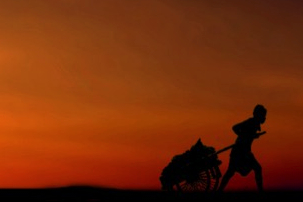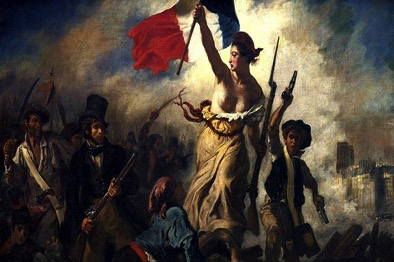In the Midst of Pain
|
In previous articles, I have talked about being a teaching assistant while attending Muskingum College. During my junior year, I took The Arts, which was a required 10-hour class that covered two semesters. While I did not ace either semester, Louie Palmer, the professor, saw something in me and asked me to be his teaching assistant during my senior year. That year of teaching several subsections each week, writing, and grading the midterms and finals both semesters was a most rewarding experience. One of the things that I learned while taking The Arts was the relationship between various types of pain and creativity. All artists are dealing with some sort of physical, emotional, or societal discomfort. Artists attempt to deal with the world in which they live by creating some sort of artistic expression. Pick any artist, and you will find someone who was addressing his or her pain.
I often use Immortal Beloved when teaching art history. It is difficult for many students to accept the idea that some sort of pain motivates artists. However, pain is the driving force behind all artistic expression. Beethoven is the classic example of how pain motivates artistic creativity.
The following video clip is from Immortal Beloved. It takes place toward the end of Beethoven's life and his Ode to Joy is being performed. During the performance, Beethoven remembers his childhood and the physical abuse of his alcoholic father, which motivated him to compose music like Ode to Joy. Beethoven was able to deal with his various painful experience over his life and create some of the most beautiful music that the world has ever heard. I want you also to watch another presentation of the Ode to Joy in a very different venue. While listening to the music, watch the reactions of the audience and especially of the young children. Beethoven was able to convert pain into awe-inspiring music, which even preschoolers can feel and enjoy. Interestingly, a century and a half after Beethoven, Duke Ellington came onto the American musical scene. In spite of overt racism in America in the first half of the 20th century, Ellington composed music and entertained millions. He said of his various pains, "I merely took the energy it takes to pout and wrote some blues."
It is critically important that each of us sees and appreciates that any form of artistic expression evolves from some sort of pain felt by the artist. However, we cannot merely accept that truth as if it applies only to those in the art world. While this relationship of pain and creativity is axiomatic in the arts, it is equally true for all people who may or not be artistically creative themselves. Pain, if addressed, is a blessing. It can motivate us to move, change, and deal with the pain we are experiencing. Why do I love teaching? What motivated me to enjoy what I do? My pain occurred when I was in my early teens. My father did not go to college due to WWII. Not long after the end of the war, he received a promotion at the company where he worked, which required us to move from Pennsauken, NJ to Pittsburgh, PA. When he and my mother were looking for a new home in Pittsburgh, he asked a realtor which community had the best schools. Mt. Lebanon was the response. Therefore, we moved to Mt. Lebanon. The result was that I went from an above average student in an average school system in New Jersey to an average student in the 19th best school system in America. The process of going to school in one of the elite schools in the entire country caused me to conclude that I was dumb. Getting Cs and occasionally Bs were not the grades that all my friends were bringing home. It took a great deal of the help, from people like Louie Palmer and many others, to show me that my conclusion about being dumb was incorrect. While I cannot play a musical instrument or even carry a tune, the pain of feeling dumb benefited me and moved me into teaching. My pain pushed me to care about teaching. I did not want other students to make the same mistake as I had. When I teach art history, I have each of my students pick an artist of their choice and determine what that artist's pain was that motivated him or her. When I would read their term papers, I was amazed at their honesty regarding what they learned from doing this assignment. They were able to determine the artist's pain but also internalize that learning and apply it to their own lives. Seeing vicariously how another person dealt with pain enabled them to begin addressing theirs. As Charles Dickens said, "It was the best of times, it was the worst of times, it was the age of wisdom, it was the age of foolishness, it was the epoch of belief, it was the epoch of incredulity, it was the season of Light, it was the season of Darkness...." It is within our capabilities to turn the worst of times into the best of times. However, it is up to you to act. If you seize the moment, you will create your Ode to Joy. In conclusion, I have written about the pain/gain issue in the art world and in my personal world. Because of my love for education, I have spent over two years overseas traveling, going to school, and teaching. Indochina is my favorite place to visit. One of the places that most interests me is Kanchanaburi, Thailand. It is the terminus of the 258-mile railroad called the Burma Railway, which went from Rangoon, Burma to Bangkok, Thailand. It is where two bridges were built over the River Kwai. The ranking POW officer, Lieutenant Colonel Philip Toosey, reflecting upon his horrific experiences as a prisoner of the Japanese said, "It was an experience, which I could not go through again, but I wouldn't have missed it for anything. It taught me so much about human beings." That was Toosey's Ode to Joy. What is yours?
Visit the Connecting the Dots page to read more about this topic.
Visit the Darkest Before Dawn page to read more about this topic.
Visit the Music I Love and Why page to read more about this topic.
Visit The Mentors and Me page to read more about this topic.
Visit the Best and Worst of Times page to read more about this topic. 03/27/15 Follow @mountain_and_me |














